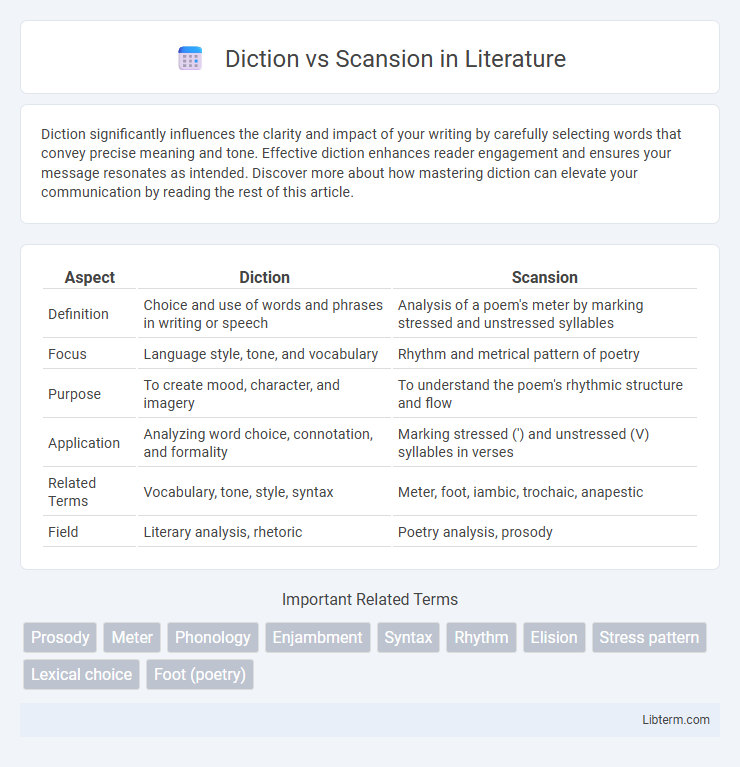Diction significantly influences the clarity and impact of your writing by carefully selecting words that convey precise meaning and tone. Effective diction enhances reader engagement and ensures your message resonates as intended. Discover more about how mastering diction can elevate your communication by reading the rest of this article.
Table of Comparison
| Aspect | Diction | Scansion |
|---|---|---|
| Definition | Choice and use of words and phrases in writing or speech | Analysis of a poem's meter by marking stressed and unstressed syllables |
| Focus | Language style, tone, and vocabulary | Rhythm and metrical pattern of poetry |
| Purpose | To create mood, character, and imagery | To understand the poem's rhythmic structure and flow |
| Application | Analyzing word choice, connotation, and formality | Marking stressed (') and unstressed (V) syllables in verses |
| Related Terms | Vocabulary, tone, style, syntax | Meter, foot, iambic, trochaic, anapestic |
| Field | Literary analysis, rhetoric | Poetry analysis, prosody |
Understanding Diction: Definition and Importance
Diction refers to the choice and use of words and phrases in speech or writing, shaping tone, style, and clarity. Understanding diction is crucial for effective communication as it influences how a message is perceived and understood by audiences. Mastery of diction enhances expression, allowing writers and speakers to convey precise meaning and evoke desired emotional responses.
Scansion Explained: Breaking Down Poetic Meter
Scansion involves analyzing the rhythmic structure of a poem by marking stressed and unstressed syllables to identify the meter, such as iambic pentameter or trochaic tetrameter. This process helps reveal the poem's underlying beat and pace, enhancing the reader's understanding of its emotional and sonic effects. By breaking down lines into feet, scansion clarifies how poets use meter to reinforce meaning and create musicality in their verses.
The Role of Diction in Shaping Meaning
Diction plays a crucial role in shaping meaning by carefully selecting words that convey specific tones, emotions, and imagery aligned with the text's themes. Precise word choice influences the reader's interpretation and emotional response, enhancing the depth and nuance of the literary work. Unlike scansion, which analyzes rhythmic patterns, diction directly molds semantic content and clarifies the author's intended message.
How Scansion Reveals Poetic Structure
Scansion reveals poetic structure by analyzing the metrical pattern of stressed and unstressed syllables within a poem, helping to identify its rhythm and form. This method uncovers variations in meter that contribute to the poem's emotional tone and emphasis, distinguishing it from simple word choice or diction. By visually mapping out the poem's beats, scansion enhances understanding of how sound and timing influence meaning and artistic effect.
Comparing Diction and Scansion: Key Differences
Diction refers to the choice and use of words in speech or writing, emphasizing tone, clarity, and style to convey meaning effectively. Scansion involves analyzing the rhythm, meter, and stress patterns in poetry to determine its metrical structure. Comparing diction and scansion reveals that diction shapes the language and emotional impact of a text, whereas scansion dissects its formal rhythmic elements.
The Interplay Between Word Choice and Rhythm
Diction shapes the texture and meaning of a poem, influencing how readers perceive its tone and emotional impact, while scansion reveals the rhythmic structure underlying the verses through the analysis of stressed and unstressed syllables. The interplay between word choice and rhythm creates a dynamic tension that enhances the expressive power of poetry, where carefully selected diction can either conform to or disrupt expected metrical patterns, adding layers of complexity. Understanding this relationship enables a deeper appreciation of how poets use language and rhythm together to evoke mood, emphasize themes, and guide the reader's experience.
Analyzing Famous Poems: Diction vs Scansion
Analyzing famous poems reveals how diction shapes emotional tone and meaning, while scansion uncovers their rhythmic structure and meter. Poets like Robert Frost use deliberate word choice to evoke imagery, whereas Emily Dickinson's scansion highlights unconventional meter that enhances thematic complexity. Understanding both diction and scansion offers deeper insight into a poem's artistic impact and linguistic craftsmanship.
Techniques for Improving Diction in Writing
Techniques for improving diction in writing include selecting precise vocabulary that conveys clear meaning and evokes specific imagery to enhance reader engagement. Incorporating varied sentence structures and rhythm patterns helps establish a natural flow, making the text more dynamic and impactful. Regular practice with reading aloud and analyzing word choice sharpens awareness of tone, clarity, and the emotional resonance of language.
Mastering Scansion: Tips for Beginners
Mastering scansion involves understanding the rhythm and meter of poetry by breaking down each line into stressed and unstressed syllables. Beginners should start by familiarizing themselves with common metrical patterns like iambic pentameter and practice reading poems aloud to identify these patterns. Using tools such as dictionaries to check syllable stress and annotating texts can significantly improve accuracy in scansion.
The Impact of Diction and Scansion on Reader Experience
Diction shapes the reader's perception by selecting precise words that evoke specific emotions and imagery, enhancing clarity and tone in a text. Scansion, the analysis of a poem's metrical pattern, influences the rhythm and musicality, guiding the reader's pace and emotional response. Together, diction and scansion create a layered reading experience by balancing linguistic meaning with auditory texture, deepening the reader's engagement and interpretation.
Diction Infographic

 libterm.com
libterm.com